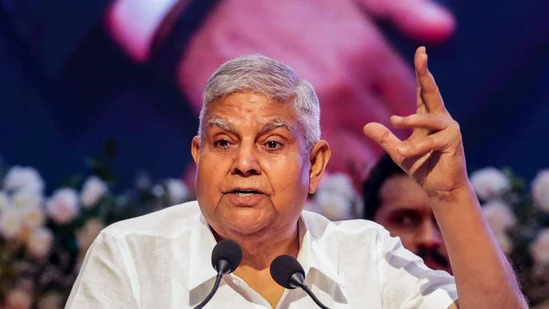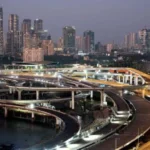Vice President Jagdeep Dhankhar’s Health Scare — A Political and Medical Emergency
In a dramatic turn of events that shook India’s political corridors, Vice President Jagdeep Dhankhar was rushed to the All India Institute of Medical Sciences (AIIMS) in Delhi after collapsing mid-event. The incident occurred during a high-profile public function, where Dhankhar suddenly fainted on stage, prompting immediate medical attention and raising nationwide concerns about his health.
Eyewitnesses described a moment of panic as aides and security personnel swiftly moved to his side. Within minutes, emergency services transported him to AIIMS, where a specialized team of doctors took over. Reports confirm that he was conscious upon arrival but visibly weakened. A preliminary statement from AIIMS stated that Dhankhar is stable, though several tests were underway to determine the cause of the collapse.
The Vice President’s health scare comes at a crucial time, both politically and symbolically. Dhankhar, known for his assertive constitutional interventions and sharp parliamentary conduct, has played a central role in recent legislative debates. The timing of the incident, coupled with reports of him submitting a letter of resignation shortly after the episode, has added layers of complexity and speculation.
According to government sources, the resignation was submitted voluntarily, citing personal health as the primary reason. However, political analysts believe the implications go beyond physical wellbeing. There are whispers in Delhi’s political circles about growing strain within the highest offices of governance, ideological dissonances, and internal fatigue from the hyperactive legislative climate. Whether Dhankhar’s health incident is an isolated medical emergency or a sign of deeper systemic pressures remains an open question.
Public reaction was swift. Social media platforms lit up with messages of concern, prayers, and political conjecture. Several prominent leaders, including Prime Minister Narendra Modi and President Droupadi Murmu, reached out to Dhankhar’s family and offered their support. “Jagdeep ji has been a pillar of our constitutional framework. We pray for his speedy recovery,” tweeted Home Minister Amit Shah.
The sudden nature of the collapse also calls attention to the health risks borne by public servants in high-stress roles. India’s political climate, marked by relentless schedules, intense public scrutiny, and constant travel, is taxing even for the most resilient personalities. Vice President Dhankhar’s collapse is a stark reminder of the human side of governance — often eclipsed by the pace of politics.
Jagdeep Dhankhar’s recent health scare has prompted many to revisit the extraordinary journey of a man who rose from modest beginnings to occupy the second-highest constitutional office in India. His story is not merely one of political ascent but a testament to discipline, intellectual rigor, and deep-rooted belief in India’s democratic framework.
Born on May 18, 1951, in Kithana, a small village in Rajasthan’s Jhunjhunu district, Dhankhar hailed from a farming family. Despite the rural limitations of his early environment, he displayed a voracious appetite for learning. He pursued his initial education locally before moving on to Sainik School in Chittorgarh, where he developed an early inclination towards leadership and debate — skills that would later define his public life.
A graduate in physics from the University of Rajasthan, Dhankhar went on to study law at the same university. His transition from science to law was driven by a growing interest in constitutional interpretation and jurisprudence. Once enrolled with the Bar Council, Dhankhar’s rise in the legal profession was swift. Known for his sharp oratory, analytical skills, and precision in courtroom strategy, he became one of Rajasthan’s most respected advocates. He would later practice in the Supreme Court of India, eventually being designated as a senior advocate.
However, it was not just his legal mind that set him apart — it was his ability to connect the law to real-world socio-political issues. This edge brought him into the political fold in the late 1980s when he joined the Janata Dal. In 1989, he won the Lok Sabha seat from Jhunjhunu, marking the beginning of his active parliamentary journey.
During his tenure as a Member of Parliament, Dhankhar made a name for himself with his focused interventions, especially on legal and agrarian matters. He was appointed Minister of State for Parliamentary Affairs in 1990 under the short-lived Chandra Shekhar government. Although his ministerial career was brief, it positioned him as a figure of national importance. His deep grasp of legislative procedures and constitutional provisions became well known.
Throughout the 1990s and 2000s, Dhankhar took on various responsibilities within the Bharatiya Janata Party (BJP) and contributed significantly to its policy and legal strategies. He maintained close ties with legal institutions and often participated in bar association events, legal reforms debates, and constitutional law forums.
In 2019, his appointment as the Governor of West Bengal was both strategic and symbolic. The post, traditionally viewed as ceremonial, became a flashpoint of federal friction under his tenure. Governor Dhankhar frequently clashed with the Mamata Banerjee-led Trinamool Congress government, asserting the primacy of constitutional order and questioning administrative overreach. His role redefined the modern gubernatorial office — no longer a passive observer but an active constitutional watchdog.
His elevation to the office of Vice President in 2022 further reflected his growing stature in the political arena. As Chairman of the Rajya Sabha, Dhankhar was tasked with managing one of India’s most complex and often unruly legislative chambers. His legal background enabled him to handle procedural nuances with authority, and he was widely praised for maintaining decorum in an increasingly polarized Parliament.
In this role, he maintained a delicate balance — upholding the sanctity of the Constitution while navigating intense party rivalries. His tenure was marked by both confrontation and cooperation. On one hand, he was known to firmly put unruly members in place; on the other, he often extended conciliatory gestures to ensure bipartisan dialogue on crucial bills.
While critics accused him of being too assertive, supporters saw in him the ideal constitutionalist — someone who believed in structure, protocol, and the supremacy of parliamentary sovereignty. As Vice President, Dhankhar’s speeches often reflected this commitment. He warned against “delegitimizing constitutional institutions through populist impulses” and frequently urged lawmakers to maintain civility and respect institutional heritage.
His health-related resignation, then, is not just the withdrawal of a man from public life — it marks the end of a distinctive chapter in India’s constitutional story. For many, Dhankhar’s journey is inspiring not because of the positions he held but the way he held them — with clarity, conviction, and an unshakable belief in the letter and spirit of the Indian Constitution.
The resignation of Vice President Jagdeep Dhankhar, following his sudden collapse and hospitalization, has left a significant constitutional void and triggered a series of political aftershocks within India’s legislative and executive framework. At a time when national politics is already navigating turbulent waters — marked by coalition recalibrations, regional assertiveness, and policy polarizations — Dhankhar’s exit has become a moment of reckoning for both the ruling establishment and the opposition bloc.
At the epicenter of this political tremor lies a key question: who will now fill the constitutional shoes of a Vice President who was not only an enforcer of parliamentary decorum but also a rare legal intellect presiding over the Rajya Sabha? While the role is technically non-partisan, the Vice President’s proximity to the political landscape — especially during contentious sessions — makes it one of subtle influence and significant consequence.
Reactions Within the NDA
Inside the National Democratic Alliance (NDA), Dhankhar’s resignation has prompted urgent strategic huddles. He was not just a constitutional appointee but a trusted figure known to align closely with the government’s legislative objectives. His ability to steer contentious bills through Rajya Sabha without procedural deadlock was critical in maintaining the government’s reform momentum.
BJP insiders acknowledge that Dhankhar was one of the few figures who could engage both legal nuance and political rhetoric with equal fluency. His departure necessitates a replacement who can combine procedural discipline with the ability to withstand opposition onslaughts. There are whispers that the Prime Minister’s Office is already evaluating a shortlist of senior leaders with both legal and administrative acumen. Names such as Harivansh Narayan Singh, the Deputy Chairman of Rajya Sabha, and even senior governors with prior legislative experience are reportedly being considered.
Opposition’s Tactical Shift
Meanwhile, the opposition — particularly the INDIA bloc — views Dhankhar’s exit as an unexpected opening. During his tenure, several opposition parties accused him of partiality, especially during controversial parliamentary suspensions and rule invocations. With the chair now vacant, the opposition senses an opportunity to push for a more “neutral” arbiter in the Rajya Sabha, especially ahead of key legislative battles over electoral reforms, economic policy, and federal finance distribution.
Leaders like Mallikarjun Kharge and Sharad Pawar have publicly called for a consensus candidate who can “restore institutional balance.” The Congress party, while acknowledging Dhankhar’s contributions, emphasized the need for a more conciliatory leadership style in the upper house. This sentiment resonates strongly with regional parties that have often felt marginalized during the past few sessions.
The Rajya Sabha in Limbo
In procedural terms, the resignation creates immediate logistical challenges. The Rajya Sabha, or Council of States, functions under the guidance of the Vice President as ex-officio Chairperson. His absence temporarily shifts authority to the Deputy Chairman. However, without a permanent Chair, the upper house risks sliding into procedural inefficiencies, especially during debates that require authoritative moderation.
Parliamentary insiders admit that Dhankhar’s firm grip on rules — and his refusal to allow disruptions to derail legislative business — kept the chamber relatively productive. In his absence, there is concern that prolonged adjournments, political showdowns, and walkouts might increase. For a nation aiming to fast-track infrastructure laws, defense agreements, and digital policy frameworks, legislative stagnation is a risk it cannot afford.
Symbolism and the Constitutional Order
Beyond politics, Dhankhar’s resignation carries deeper symbolic weight. It underscores the human toll of holding constitutional office in India’s current political climate — an environment where relentless pressure, media scrutiny, and ideological polarization have become the new norm. His medical emergency serves as a poignant reminder of the stress public figures endure behind the scenes.
Moreover, his departure is being interpreted by some scholars as a symptom of systemic fatigue — where the burden of institutional responsibility increasingly rests on too few shoulders. In a healthy democracy, the Vice President serves as a balance between executive ambition and legislative restraint. The sudden withdrawal of such a figure, especially one with Dhankhar’s experience and legal authority, is a jolt to that equilibrium.
International Response and Media Optics
Internationally, Dhankhar’s resignation has drawn cautious attention. Several diplomatic missions in Delhi privately acknowledged the Vice President’s role in fostering constitutional consistency amidst political headwinds. Media outlets from the U.S., U.K., and the EU have noted the development, especially given India’s rising global profile and ongoing engagements with G20, BRICS, and Indo-Pacific coalitions.
Back home, television studios and digital platforms are ablaze with speculation. Some right-leaning commentators see it as a moment of vulnerability for the ruling alliance, while others frame it as a dignified exit by a leader who prioritized health over power. Liberal analysts, on the other hand, interpret it as a sign that institutional overreach may have reached its saturation point.
What Lies Ahead
In the coming weeks, the nation’s political gears will grind into motion to identify a successor. But finding another Jagdeep Dhankhar — someone who can combine constitutional literacy with administrative toughness — will be no easy task. The search will be shaped not just by political calculations but also by the lessons of Dhankhar’s own journey: the importance of constitutional fidelity, the weight of procedural integrity, and the fragile balance of power that defines India’s democracy.
With the sudden resignation of Vice President Jagdeep Dhankhar, the machinery of the Indian Republic finds itself at a critical constitutional crossroads. The position of the Vice President is not merely ceremonial — it is vital to the functioning of Parliament and, by extension, to the overall stability of India’s federal democratic structure. As the nation begins the formal process of identifying and electing a new occupant to this office, it is imperative to understand the framework, timelines, and political stakes involved.
Understanding the Role: Not Just a Stand-In President
The Vice President of India is the second-highest constitutional office in the country, ranking just after the President. Article 63 of the Indian Constitution mandates the existence of a Vice President, while Article 64 designates the officeholder as the ex-officio Chairperson of the Rajya Sabha. In simpler terms, the Vice President is not just a successor-in-waiting for the presidency; they are also the daily moderator of one of the most crucial chambers of India’s bicameral legislature.
Dhankhar, during his tenure, played this role with assertiveness, presiding over key debates, invoking rules to curb disruptions, and steering legislative conversations with a clear legal bent. His absence, therefore, has disrupted not only the symbolic headship of the upper house but also its functional equilibrium.
Article 66 and the Electoral Process
The process to elect a new Vice President is governed by Article 66 of the Constitution. The Vice President is elected through an electoral college, distinct from that of the President. It consists of members of both houses of Parliament — Lok Sabha and Rajya Sabha — but does not include state legislative assemblies. This means that 543 Lok Sabha MPs and 245 Rajya Sabha MPs (including nominated members) will cast votes to determine the successor.
The election is conducted via a single transferable vote system and the ballot is secret, ensuring that party whips cannot mandate how MPs must vote. The candidate who receives the majority of valid votes cast is declared elected.
The Election Commission of India (ECI) is tasked with issuing the formal schedule, overseeing the nomination process, ensuring ballot security, and announcing the results. Given the urgency of the constitutional vacuum, it is expected that the ECI will fast-track the timetable and announce dates within a fortnight.
Nomination Mechanics and Eligibility
A candidate wishing to contest the Vice Presidential election must meet the following conditions:
- Be a citizen of India.
- Be at least 35 years of age.
- Be qualified to be elected as a Rajya Sabha member.
- Not hold any office of profit under the Government of India or state governments.
Additionally, a nomination must be backed by at least 20 MPs as proposers and 20 as seconders, along with a security deposit of ₹15,000. The paperwork is scrutinized by the Returning Officer (usually the Secretary-General of the Lok Sabha or Rajya Sabha), and objections, if any, are addressed before the final list of candidates is released.
The Politics of Succession: Who Are the Contenders?
In Delhi’s tightly woven political ecosystem, names are already being floated behind closed doors. Given the strategic nature of the Vice President’s position — both as Rajya Sabha Chair and a potential presidential successor — the choice will reflect the political intent of the ruling coalition and the message it seeks to send nationally.
Probable Candidates Backed by NDA:
- Harivansh Narayan Singh: The current Deputy Chairman of the Rajya Sabha, a seasoned parliamentarian from the JD(U), could emerge as a consensus candidate backed by the BJP-led NDA.
- Justice (Retd.) Ranjan Gogoi: Though controversial due to his post-retirement appointment to Rajya Sabha, he represents a judiciary-turned-legislature transition that appeals to the BJP’s institutional narrative.
- Dr. Sudha Murty: Though speculative, her name has appeared in several internal BJP think-tanks as a figure with cultural gravitas and administrative credibility.
Possible Opposition Picks:
- Ghulam Nabi Azad: A veteran with bipartisan respect, Azad may be pitched as a unifying figure by the INDIA bloc.
- Sharad Yadav (posthumous respect still strong) or a representative from regional heavyweights like DMK or TMC could be part of coalition-bargaining.
The BJP’s comfortable numerical advantage in the Lok Sabha and increasing traction in the Rajya Sabha mean the NDA’s nominee will likely sail through — unless opposition parties pull off a rare united front and attract cross-voting.
Timelines and Interim Arrangements
The Constitution is silent on a mandatory timeframe for electing a new Vice President after a resignation, but political convention and administrative necessity dictate urgency. The Election Commission is expected to notify the schedule soon, and a new Vice President could be sworn in within 60 days of the office falling vacant, as per precedents.
In the interim, the Deputy Chairman of the Rajya Sabha will preside over the proceedings. However, the absence of a permanent Chair limits the authority to invoke disciplinary procedures and ensures that contentious debates may become harder to manage.
Legal and Constitutional Implications
This transition period raises several legal considerations:
- If an important bill is challenged in the Rajya Sabha during this vacuum, procedural errors can be contested in court.
- If a constitutional crisis emerges — say, simultaneous absence of both the President and Vice President — it could trigger emergency provisions or temporary appointments.
Experts argue that India must now revisit the robustness of constitutional succession and look at reforms to tighten timelines and procedural clarity during such vacancies.
Public Sentiment and Symbolic Importance
While public sentiment remains largely sympathetic to Dhankhar, there’s a growing discourse about the pressure constitutional figures endure and the need to institutionalize better health safeguards, retirement mechanisms, and transparency standards in the appointment and resignation processes of high offices.
Also Read : PM Modi Reacts as Jagdeep Dhankhar Resigns as Vice President: ‘Got Many Opportunities to Serve the Country’








